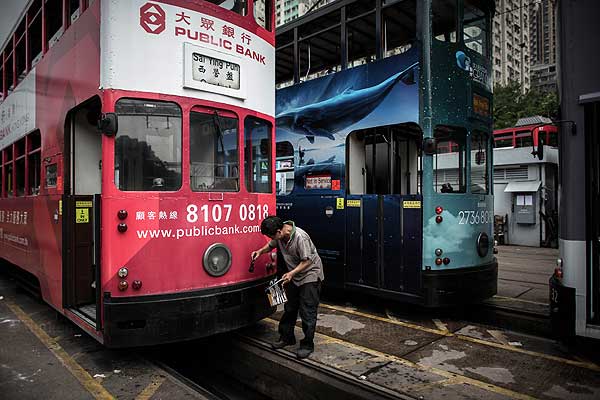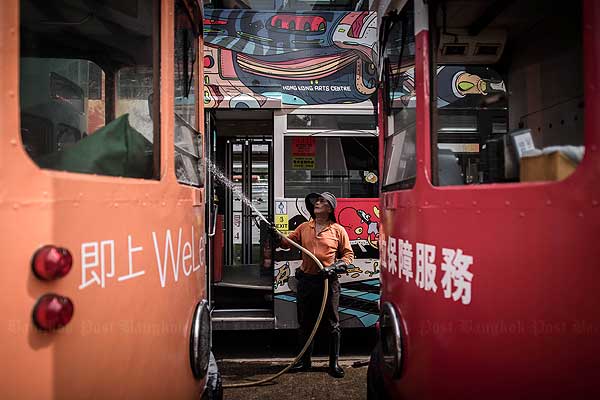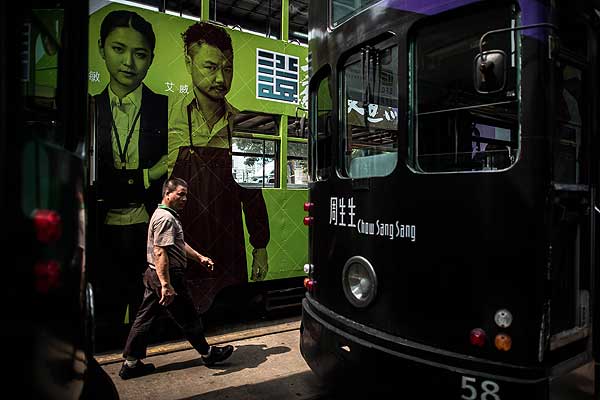
By Ajarn Helen Jandamit
Photos courtesy of AFP
University Tips is here to help you prepare for the English exams and tests that are coming your way. It gives you practise answering questions similar to those you may have at school and also on the University Entrance Examination.
Read the following story from the Bangkok Post. Then, answer the questions that follow.
A controversial new proposal to take Hong Kong's beloved trams off the streets has angered residents who fear losing the city's past.
FAMILIAR SOUND
Known as ding-dings for the sound of their bells, trams have served the northern coastline of the city's main island for more than 110 years and still carry around 200,000 passengers a day.
As development changes the city, sweeping away many of its historic landmarks, trams have survived growing competition from buses and the modern MTR metro system.
SLOW LIFE
But many people fear that the trams are also under threat. Thousands signed petitions against the suggestion that the tram service should be removed from the main financial district of Central.
The proposal was put forward to the government's official town planning body by consultant Sit Kwok-keung, a former planner, who argues that the tram service is too slow, blocks traffic and is unnecessary as the MTR expands. The Hong Kong government however said it had no plans to remove the trams.
PUBLIC VOICE
"Public sentiment is strongly against this idea," activist Kwong Sum-yin, who is leading the "Save the Trams" campaign, said. "Trams are forward-looking as a form of zero-emission transport when the world is talking about sustainability."
Instead Kwong's group, the Clean Air Network, is proposing a car-free zone in Central to ease congestion and make way for more trams to run.
"We are losing our history," Kwong said.
TRAM JAMS
With 163 cars, Hong Kong's tram network is the world's largest fleet of double-deck tramcars still in operation, charging a flat rate of just HK$2.30 (10.60 baht) for adults to ride the 120-stop system.
Hong Kong Tramways’ managing director Emmanuel Vivant argues that trams are not to blame for traffic congestion.
"Everybody knows the reason for the jams is the 50 percent increase in the number of vehicles over the past 10 years," he said.
MOVING MUSEUMS
But despite public support for the tram system, Sit Kwok-keung says it is time for a review.
"Efficiency is the most important thing to every person," he said. Sit added that if his proposal for Central went through, he would suggest removing all the trams in the city. He argues that they should be turned into mobile museums instead.

Exercises
Section 1
Read the story and answer the following multiple-choice questions.
1. Why are trams in Hong Kong known as ding-dings?
a. Due to the sound of their bells.
b. Due to the colour of the paint used on them.
c. Due to the sound of their ticket machines.
2. How long have Hong Kong’s trams been operating?
a. For the past 10 years.
b. The story does not say.
c. More than 110 years.
3. How many passengers do Hong Kong trams carry each day?
a. About 110 passengers a day.
b. About 200,000 passengers a day.
c. About 50 percent more than 10 years ago.
4. Who is Hong Kong Tramways’ managing director?
a. Sit Kwok-keung.
b. Kwong Sum-yin.
c. Emmanuel Vivant.
5. Why does Sit Kwok-keung want to remove the tram service from the main financial district of Central?
a. He thinks that the service is too slow and blocks traffic.
b. He thinks that the service is unnecessary since the MTR is expanding.
c. He thinks both the above.
6. How many cars are there on Hong Kong's tram network?
a. 163.
b. 120.
c. 110.
7. What does Sit Kwok-keung suggest the trams should be turned into?
a. A tram network
b. Mobile museums
c. A car-free zone in Central
8. What is the Clean Air Network proposing?
a. A car-free zone in Central.
b. Thousands of signed petitions.
c. Turning trams into mobile museums.
Section 2
Read the story and decide whether the following statements are true or false.
9. Hong Kong's trams have two floors.
………………………
10. According to Emmanuel Vivant, there has been a 50 percent increase in the number of vehicles in Hong Kong over the past 10 years.
………………………
11. There are 163 tram stops on Hong Kong's tram network.
………………………

Section 3
Read each of the following sentences and underline the grammatically correct words in each from the choices given.
12. The supervisor said he had no plans for/about/ to remove the machines.
13. There has been a 50 percent increase in/of/over the number of driving offences recently.
14. Local police is/are/were not to blame for the traffic congestion last Saturday.
15. Residents fear losing/lost/had lost the city's past.
Section 4
Fill in the blanks in the following passage with the correct words from the choices given.
Protests triggered by Sit's proposal have even included a "Man vs Tram" race …..16….. counter his claim that trams are slow. About 40 people took …..17….. an in-service tram over nine kilometres, but even accounting for …..18….. tram's numerous stops only a handful of competitors outran …..19…..
16.
a. for
b. to
c. since
17.
a. off
b. on
c. out
18.
a. a
b. those
c. the
19.
a. it
b. them
c. us
Section 5
Write down the verb forms of the following words used in the story.
20. development ……………….
21. proposal ……………….
22. modern ……………….
23. sustainability ……………….
24. suggestion ……………….
Vocabulary
- landmark (n): something, such as a large building, that you can see clearly from a distance and that will help you to know where you are
sustainability (n): that can continue or be continued for a long time
congestion (n): the state of being crowded and full of traffic


